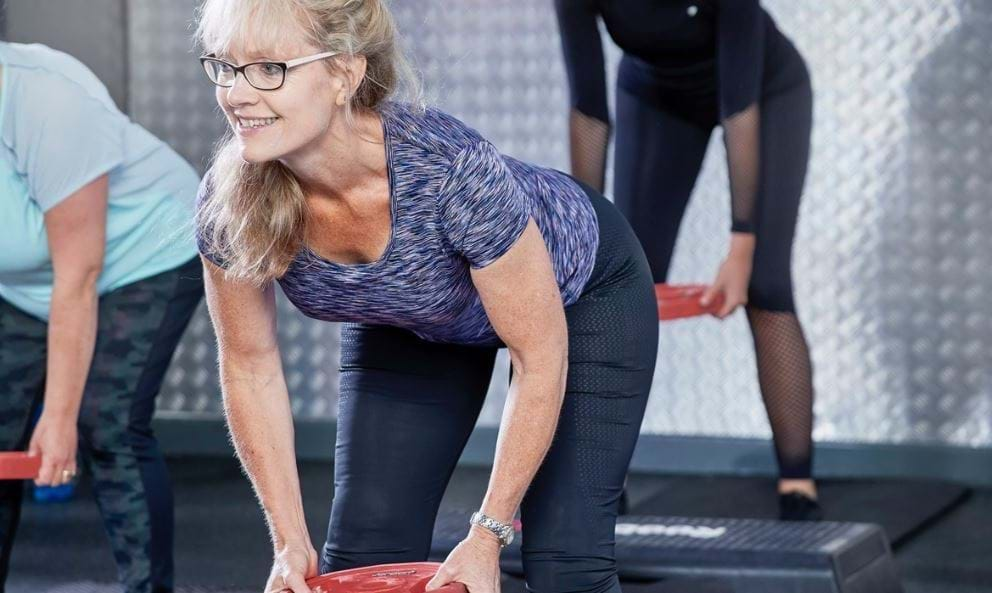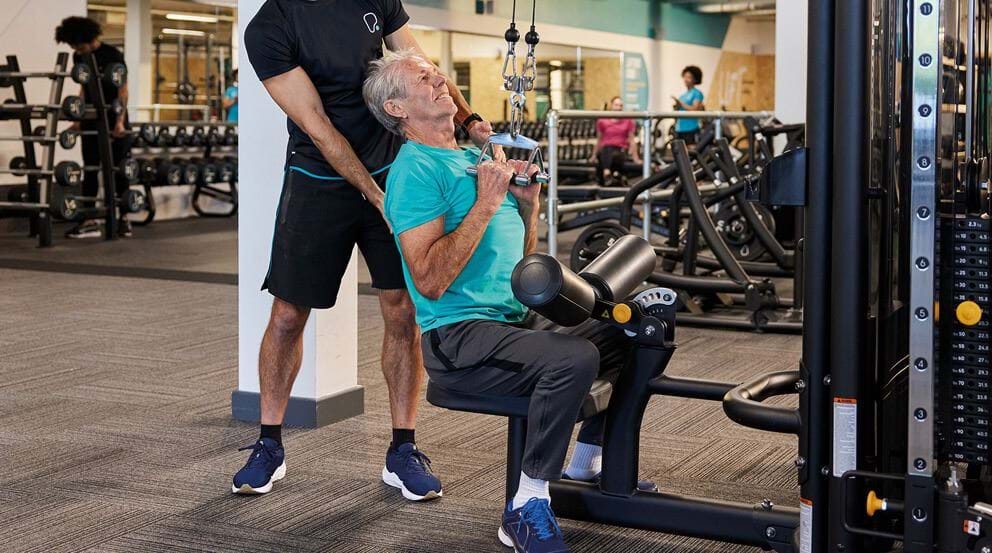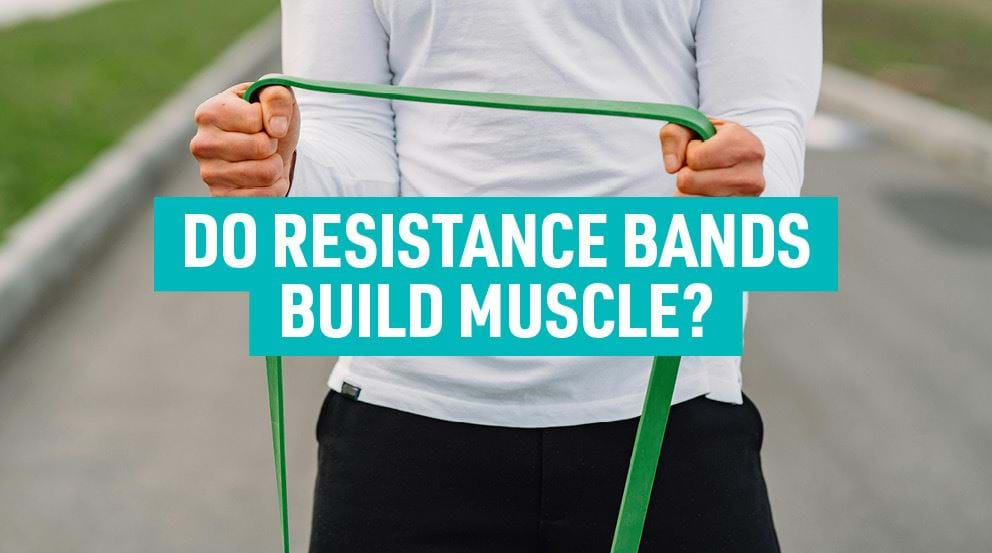8 Back Strengthening Exercises For Seniors

Benefits of back strengthening exercises for seniors | Common causes of pack pain in seniors | Back exercises seniors should avoid | The best back strengthening exercises for seniors | Is walking good for strengthening your back
Having weak, tight, or imbalanced back muscles can cause pain in people of all ages, but this can be magnified as we get older due to the degeneration of both soft and hard tissues (like muscle and bone). Studies have shown as many as 70% of older adults struggle with back pain!
Having weak back muscles and/ or back pain can limit mobility in seniors, and this can speed up muscle degeneration and further reduce mobility -- it's a case of use it or lose it.
In this blog, Personal Trainer Phil Burrows, who works with GP referrals and specialises in postural correction, looks at some of the best back strengthening exercises for seniors.
Benefits of back strengthening exercises for seniors
Back strengthening exercises for seniors can help to prevent and correct weak or imbalanced back muscles and reduce back pain.
Other benefits include:
- Improving strength, balance, and stability
- Reducing stiffness and increasing mobility
- Maintain independence
- Prevent kyphosis (excessive curvature of the spine)
Check out some of the best exercises for improving balance in seniors here.
Common causes of back pain in seniors
Anyone can experience back pain, but there are certain factors that make older people more prone to having weak, tight back muscles and back pain:
Muscle atrophy. As we age, our soft tissues start to degenerate. Muscle atrophy, the loss of skeletal mass, leads to decreased strength and a reduced ability to support the spine.
Bone loss. In later life, our bones produce more osteoclasts (responsible for bone reabsorption) than osteoblasts (responsible for bone formation) which causes the bones to deteriorate and thin. This can lead to osteoporosis, a condition that occurs due to reduced bone mass and bone mineral density, leaving weak brittle bones, including in the spine.
Poor posture. Poor posture, both sitting and standing, can wreak havoc on our bodies. For example, hunching over leads to tight, weak muscles in the back and shoulders which can cause pain. The body responds to this by using the chest muscles more, which further weakens and tightens the back muscles -- so if poor posture begins at an early age, it gets increasingly worse as we get older. This can mean significantly bad posture and pain as we reach senior age. Kyphosis (excessive curvature of the spine) can occur over time due to hunching and can cause significant pain.
Overuse. Repetitive activities take their toll on our bodies. Sleeping in poor positions, sitting for long periods of time, heavy lifting, etc, all place small amounts of stress on our backs. Over time this builds up -- so it's no wonder we become more susceptible to back aches as we age!
Inactivity. As we get older, particularly after retirement, some people become less active. A sedentary lifestyle has many risks, including decreased skeletal mass, excessive weight, and muscular atrophy, that can cause or worsen back pain. Sitting for long periods of time can also lead to a weak posterior chain, which can worsen posture.
Degenerative conditions. As we get older, we are more likely to struggle with degenerative conditions like arthritis that can lead to, or worsen, back pain.
While exercise is a great tool for seniors to build and maintain a strong and stable spine, some exercises can do more harm than good.
Avoid exercises which hyperextend the spine (such as backbends) and stay away from big lifts (like squats and deadlifts) using heavy weights. With these types of exercises, any breakdown in form can result in the spine overcompensating. If you are interested in these exercises, start by building your back and core strength first, and then slowly building up from bodyweight, making sure to really get the form right. Working with a PT is a great way to ensure your technique is correct.
The best back strengthening exercises for seniors
Strengthening the muscles which support your spine helps to combat several of the factors that lead to weak back pain and muscles, including muscle atrophy, bone loss, poor posture, and inactivity.
The spine is supported by a whole system of muscles including:
- Extensor muscles -- the muscles in the back e.g. traps, lats, and the glutes.
- Flexor muscles -- muscles attached to front of spine e.g. abdominals. The extensor and flexor muscles are intrinsically linked: as one lengthens, the other shortens. When it comes to building a strong and stable spine, strengthening these muscles is just as important as strengthening the back muscles.
- Obliques -- muscles to side of spine
The hamstrings and hip flexors also play a part in good spine health, as they can impact pelvic alignment, which can affect the alignment of the lower spine.
The below easy back strengthening exercises for seniors will help to strengthen all these muscles. We've opted gentle, low impact exercises that use bodyweight or resistance bands, as it's important for seniors to slowly build their strength up before working with heavy weights or trying high impact exercises.
Try doing each of these exercise for 10 reps and work your way up to 3 sets of 10 reps over time.
Superman
The superman is one of the best lower back strengthening exercises for seniors. It also works the abdominals, and erector spinae. Focus on recruiting the lower back and core muscles to power this movement, rather than on speed.
- Start by laying on your front on the ground. Relax your neck and extend your arms forward.
- Slowly lift your chest and arms off the ground by contracting your lower back.
- Hold this position for the count of 3 then slowly return.
Cobra Lat Pulldown
This exercise works your latissimus dorsi, the largest muscles in your upper body. The lats start below your shoulder blades and stretch from your spine to your sides, and helps to stabilise both the spine and the shoulders.
- Lay on your front and place your arms out to your side, elbows bent at 90 degrees, so your forearms are parallel with your spin.
- Relax your head and neck, then extend your arms forward.
- Pause before pulling your arms back to the starting position. Focus on drawing your lats back to really drive this movement.
Seated Torso Twist
Seated torso twists recruit almost all the muscles in the core and back. It both strengthens and stretches these muscles, so it's good for both building a strong core and improving mobility.
- Sit down on a chair, feet flat on the floor, and spine tall.
- Raise your arms while keeping a 90 degree bend in the elbow, so your upper arms are in line with your shoulders, and your forearms are parallel to your body, with your palms facing forward.
- Brace your core and then slowly rotate your torso to the left as far as you can comfortably go.
- Pause, then bring your body back to the middle (neutral), before rotating to the right.
- Rotate back to neutral. This is one rep - repeat for 10 reps.
- Make sure to focus on using your core and back muscles to control the movement, rather than aiming for speed.
Seated Banded Pulldowns (Two Variations)
Resistance bands are a great way to build strength. This exercise has two variations; the first works the lower traps and lats, while the second activates the upper traps more. You can alternate between the two or carry them out separately.
- Secure the resistance band around a door frame, squat rack, or sturdy frame.
- Sit down on a chair so you're facing the resistance band. The bottom of the band should sit above your head.
- Grab the band with both hands and pull it down below your chest, keeping your elbows tucked in tight to your torso.
- Return the band back to the start and repeat.
For the second variation of this exercise, pull the band until it's in line with your upper chest, and allow your elbows to lift up and out, rather than keeping to your sides.
Glute Bridges
Glute bridges work your hamstrings, glutes, lower back, and core, and are great for combatting poor posture and weak muscles caused by excessive sitting.
- Lie on your back with your feet flat on the floor, knees bent facing the ceiling.
- Brace your core and push your hips up towards the ceiling while squeezing your glutes, until your shoulders, hips, and knees are in a straight line.
- Hold for the count of 3 while squeezing your glutes.
- Slowly return to starting position.
Bird Dog
This exercise works the lower back, glutes, abdominals, erector spinae, and shoulders, and it helps to improve balance and stability too.
- Start on your hands and knees, with hands under shoulders and knees under hips. Your spine should be neutral.
- Engage your core, pull your shoulder blades together, and tucket your chin into your neck.
- Slowly raise your left arm while extending your right leg, until they are both parallel with the floor.
- Hold this position for a second before lowering back to the start.
- Repeat on the other side.
Rock ups
Having strong abs helps to maintain good spine health, but it's important to avoid hyperextending the spine in any ab exercises. If you find that sit ups hurt your neck, it's likely that your abdominal muscles aren't strong enough to lift your weight, so other muscles are having to compensate. Rock ups have a smaller range of motion than sit ups and can be used to build up your core strength without straining the spine.
- Lie on your back, feet flat on the floor and knees facing the ceiling. Place your hands across your chest and engage your core.
- Focus on using your abdominals to lift your shoulders off the floor.
- Once your shoulder blades raise up, return back to the starting position.
Reverse Crunches
Reverse crunches are another exercise which targets the abs without placing pressure on the spine. Try these by themselves, or superset them with rock ups.
- Lie flat on your back, feet flat on the floor with your knees bent at 90 degrees.
- Lift your legs off the floor so your thighs and torso are at a 90 degree angle, and your shins are parallel with the floor.
- Place your hands behind your head -- this helps to counterweight your legs. You can also hold on to an anchor behind your head if needed.
- Brace your core and then focus on using your abs to pull your hips off the floor and bring your knees towards your chest.
- Slowly return back to the start and repeat.
Is walking good for strengthening your back?
Walking often gets overlooked in favour of more intensive exercises, but it is a great form of low impact exercise -- especially for seniors! Walking regularly can help to maintain bone density, increase blood flow, and work the muscles supporting the spine, making it a helpful tool for maintaining back strength. Walking regularly can also help seniors to maintain a healthy weight, which can ease back pain.
We'd recommend walking in conjunction with back strengthening exercises, rather than a standalone solution. Swimming is also an excellent low impact option for aerobic exercise.
Back pain is a pain, but it doesn't have to be. Strengthening the supporting muscles through resistance training will help to build a strong and stable spine, and can help to improve bone density too. Once you've built up a good base strength with these exercises, you can move on to using dumbbells and resistance machines to further strengthen your back muscles.
It's important to build strength in all muscle groups, especially as we age. Check out our Exercise Advice For Over 50s hub for more senior-friendly workouts, or work with a Personal Trainer who can build a workout plan that is tailored to your current ability and goals.


